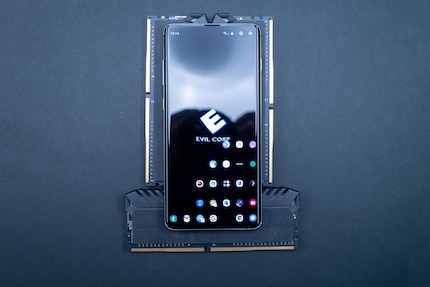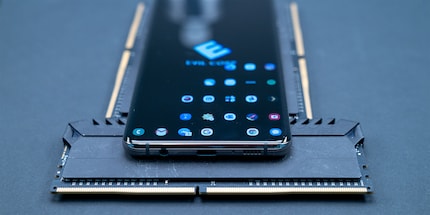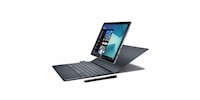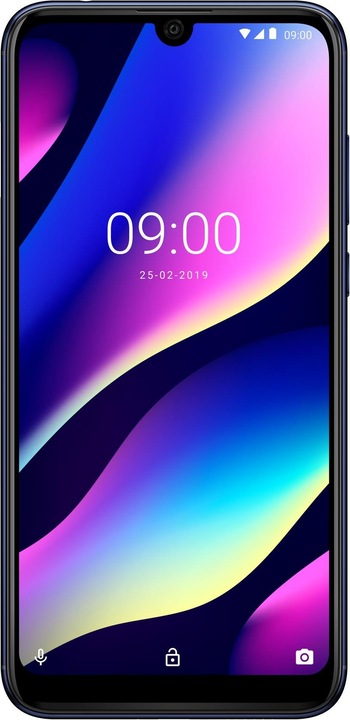
Samsung Galaxy S10+ Ceramic and why we need 12 GB RAM
With 12 GB RAM and a terabyte of internal storage, the Samsung Galaxy S10+ Ceramic is the clear front-runner. But the question is, who needs something like that? Honestly? The world. Let's do the maths.
Samsung Galaxy S10+ Ceramic is a feat of technology. It comes with 1000 GB internal memory, 12 GB RAM and a 6.4-inch screen. That's 16.256 cm. Those are the only differences between the ceramic version and its little sister, the Samsung Galaxy S10+.
The question is,
Why do you need a 12 GB RAM mobile?
In short, that's a bold question and one that's complicated to answer. Eldasch spoke for a lot of users when putting forward this question, and I'd like to dedicate this entire article to responding to it.
To do this, we need to take a broader view, which is quite un-Swiss of me. We need to think more internationally than just our own pocket or the S12 commute to Zurich's Hardbrücke. So forget #square4life a moment. We're global players now.
The easy bit: the terabyte of internal storage
It's easy to explain the reasoning behind the internal storage – even though no one asked about it. The S10+ Ceramic doesn't just come with 1000 GB internally memory. You can also add another 512 GB with a memory card. In Switzerland, 1.5 TB storage is pretty useless in a smartphone, unless you're one of those scatterbrains who's against Cloud and streaming services. And that's exactly where our international context has to come in.

There are places in the world where idealists and so-called normal people are in the same boat and don't have a choice. Take London, for example. There are 402 km of underground lines in the UK capital, some of them up to 58.5 m under the ground. Every day, 5 million people use what Londoners call the tube. Not even the strongest 5G transmitter mast can send signals that far below ground. Compare that to Switzerland, where we've been complaining about bad signal in places like the Matterhorn and Mörschwil in canton St Gallen for years.

Source: flickr.com/stewdean
But when you're on the tube, you still want to be able to listen to music or podcasts – if we're carrying on with the Swiss comparison. After all, it's probably one of the most used features on Swiss commuter trains. While the Swiss commute [61.2 minutes](in German)(https://www.bfs.admin.ch/bfs/de/home/statistiken/mobilitaet-verkehr/personenverkehr/pendlermobilitaet.html) per day, Londoners spend 74 minutes on their daily commute. Just imagine you had no reception the whole time. That's an example of when internal storage is incredibly important. Want to listen to music? Use Spotify offline or MP3 files. Want to watch videos? Try NewPipe downloads or MP4 files. But all of that takes up memory. Or maybe just read a book or the paper. Whatever.
In this case, London is just a placeholder for «places that aren't Swiss apart from Mörschwil as well as undergrounds or other places where phone signal is difficult». Just so we've come full circle with not looking beyond our own noses.
The difficult question: explaining the 12 GB RAM
When you look at the RAM, things get a bit more complex. There's no obvious answer along the lines of «there's no reception» to warrant the 12 GB RAM. First and foremost, it's a feature both Samsung and Ceramic S10 users can boast about. For Samsung, it also represents an area where they can mop up a bit more cash. Having said that, the smartphone industry doesn't make its money from the big, expensive flagships. And certainly not Samsung. In the electronic world, they do a bit of everything, but they invest heavily in technology that enables other technology. Think screens and semiconductors.
That's all well and good but what use is the 12 GB RAM to you, the user? Nothing. Honestly, absolutely nothing. Apart from special use cases, you're never going to need the 12 GB RAM or even notice it. As it is, the 8 GB RAM in the S10+ is sufficient and the phone never goes slow. And there's a very good reason for that. But once again, we have to leave #square4life behind and think outside our own borders.
Unlike its competitor Apple, Android has democratised smart technology. All of a sudden, everyone had access to smartphones. It's no longer just for those who can drop over 1,000 francs on a device. In Switzerland, old fashioned, parochial types get to choose how much they spend on a computer. Not everyone has this luxury.
We can also look at what's known as the iPhone Index. Analysts at major bank UBS calculated the index based on average wages around the world. If I remember correctly, the device would have set you back 1299 francs at launch. Zurich came in first place in the index, meaning you'd have to work 38.2 hours here to afford a new iPhone X. Second place goes to Gent with 47.5 hours. And in last place was the Egyptian capital Cairo, where you have to work 1066.2 hours to afford an iPhone X.

Cairo is at the bottom of the stats. There are no doubt other places in the world where the situation is worse. I'd imagine Cambodia or the Republic of South Sudan would be candidates. But these aren't on UBS's list, which is why we can't include them in the article.
Interestingly, we have enough stats to be able to do a direct comparison for the Samsung Galaxy S10+ Ceramic.
- In Zurich you'd have to work 47.9 hours to buy a Samsung Galaxy S10+ Ceramic
- In Gent you'd have to work 59.6 hours to buy a Samsung Galaxy S10+ Ceramic
- In Cairo you'd have to work 1337.1 hours to buy a Samsung Galaxy S10+ Ceramic
This is obviously based on the average wage.
But #square4life people feel vindicated. That’s way too expensive, in their opinion. Scandalous even. At pubs around the country, they'd be slamming their fist on the table – but not too loud, obviously, as someone might hear them. And, of course, they'd utter the phrase «Someone should do something about that». But in Cairo, it's a different question. Digital life doesn't distinguish between rich and poor. Jobs can be awarded online and speed is often essential for survival. Take Fiverr, for example. This internet platform lets you outsource all kinds of computer work on a case-by-case basis. For as little as 5 US dollars. Being able to outsource a new company logo or coding job to Egypt or Pakistan for 5 francs doesn't sound like much. A few hours later, the coder or graphic designer sends you the work. It might not be Swiss quality or come with the customer service we're used to but it gets the job done. For something like that to be possible, a coder or graphic designer in Cairo has to think globally and be accessible. In other words, they need a smartphone. But there, a smartphone isn't just about communication. To afford the phone, they might have earned the equivalent of 5 days' local work within a few hours by creating a logo for a Swiss client for their vegan, gluten-free fitness blog.

The Android question comes in here, as the iPhone topic doesn't even come into it. Say you use devices like Wiko. It's a lot of phone, mostly dual SIM for not a lot of money. The brands don't splash out on manufacturing. So 12 GB RAM in a phone for less than 100 francs sounds utopian. In reality, these kinds of phones only come with 3 or 4 GB. And yet, if you pick up a Wiko phone, you'll see it actually works quite well. The photo quality might not be that good and perhaps the screen isn't great either. But you'll still be able to work fast and the battery has staying power. In short, it looks good to me.
Although we can't give all the credit to the hardware manufacturers that make great devices. Software companies play their part, from Google all the way to app developers in Swiss start-ups. Because almost every app is designed to work and give users a good experience on all Android devices, even low-end devices. What that means is all the apps in the app store right now, be it WhatsApp or Fortnite, are optimised for roughly 4 GB RAM. Of course, it might sometimes be a bit of a stretch, but it should work. In other words, 12 GB can promise great performance but if you don't have any apps that use or need it, it's not much use.
So what's the point of it then?
And that brings us back to Eldasch's question of who even needs that amount of RAM. We manage to get an answer, or you could say a solution, from user Lerkes:
The use case is probably more in combination with the DeX Docking Station than normal mobile phone use.
That's true. Samsung is the forerunner when it comes to bridging the gap between smartphones and PC – even though DeX hasn't been implemented yet and probably won't be implemented in its current form. So are Samsung just doing this to show off? In a kind of «hey, look what we can do» way? Not quite. For one thing, they obviously want to make sure it's possible tech-wise to build 12 GB RAM into a smartphone. And then if it's possible to mass-produce it for the market. Then there's also the issue of whether or not Samsung can collect data when they sell the 12 GB phone. How many will they sell? Where? What will they be used for?
Samsung is sending a clear signal to the rest of the industry with S10+ Ceramic. Devices such as the Samsung Galaxy S10+ Ceramic have the advantage of appealing to tech fans, who'll think it's cool. That includes their competitors, who'll then follow suit. At some point, you get apps that use the system to its full potential. There also comes a point when 8 GB RAM devices are so cheap that even a coder in Cairo can afford them. At some point, that will happen with 12 GB phones, too.
As you can see, the world doesn't stand still. Unlike #square4life with its ideal of the imaginary 1950s years with Beano charm. Instead, the world continues to evolve and gets more technologically advanced and developed. Advances in smartphones happen all around the world. Otherwise, places like Cairo end up in the position where they don't stand a chance of keeping up. Cairo comes at the bottom of the stats table, while places like Zurich are forerunners in terms of tech. That's why we are in the privileged position of saying «No one needs that». No, you might not need it. I might not need it. But the world needs it.
A lot is going on right now behind the scenes. Manufacturing techniques for 12 GB phones are getting cheaper and easier. Meanwhile, the competition doesn't rest – it joins in. Maybe Huawei will find a way of simplifying the manufacturing process even more. Prices would fall as other manufacturers would get involved. And that is how the democratisation of 12 GB phones begins.

And yet, discrepancy would still be there on an economic and technological level. Because in a couple of years when 12 GB phones are the norm and selling for Wiko prices, in #square4life, we'll be asking what we need 32 GB phones for. The answer will be the same. But in Cairo, coders will have access to more technology for a price tag they can afford. That has a knock-on effect on the other end of the spectrum. In five years, Cairo's economy isn't likely to be much more competitive than today when you compare it on a global level. However, their reality will be improved thanks to technological advances.
If you look at the specs on a current Wiko phone, you'll be met with the same kind of data you'd have been surprised at a few years ago. In marketing speak, these phones would have been «technology milestones» of their time. But for #square4life, they're ready for the bin. In comparison, someone in Cairo would consider this technology an opportunity to make a fiver off the west. For us, a fiver is neither here nor there, while in Cairo it's what you'd normally earn in a week.
Side note: what I'm describing here probably sounds utopian. If we look back at this article in five or ten years, the answer will probably be just as right and utopian as in 2019. That’s a shame. But I can still dream of a utopia birthed out of technology. Maybe if enough of us dream about it, it might come about.
There'd certainly be something in it for the manufacturers. After all, when technology and manufacturing get cheaper, prices drop. For instance, a phone that costs 90 francs today would set you back 10 francs. This would mean a lot more people could afford it, and with some skills under their belt, they could become part of the fiver workforce. All the while, Samsung and Co. would be selling more phones, both in the relevant flagship segments and in the low-price segment. In turn, this would get more money to flow into the company's coffers, which I'm sure they'd be happy about.
And there you go. By the way, did I mention the S10+ Ceramic takes great selfies?
Journalist. Author. Hacker. A storyteller searching for boundaries, secrets and taboos – putting the world to paper. Not because I can but because I can’t not.
Interesting facts about products, behind-the-scenes looks at manufacturers and deep-dives on interesting people.
Show all




